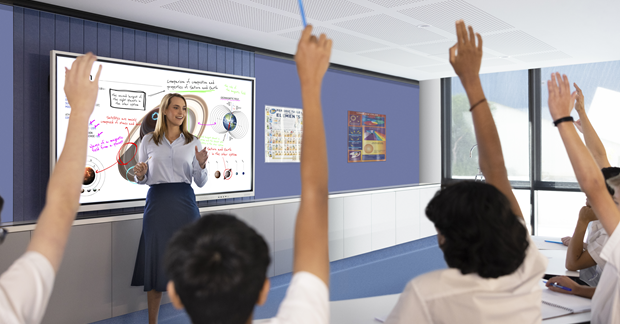How connected campus experiences are reshaping learning outcomes at Aussie schools

As technology continues to shape many aspects of everyday life, Australian schools are embracing digital learning tools to empower teachers and enhance student outcomes.
Campion research shows nearly 40 per cent of Australian schools are looking to accelerate their technology strategy and become highly tech-enabled in the short to medium term. Schools reported that improving learning outcomes is the biggest driver of their digital strategies, followed by accessibility for learning styles/capabilities and student connectivity benefits.
Most Australian schools have now solidified their hybrid learning strategies, with 61.5 per cent saying they use both digital and printed tools and resources. The next challenge is to extend investment beyond basic connectivity use cases to achieve more transformative benefits.
Digital technology promises to deliver better outcomes for students all over the country, creating more interactive and collaborative learning environments that keep students focused and engaged. But with limited resources and teacher shortages, investment must focus on easily implemented solutions that deliver a real and powerful impact.
That’s influencing the rise of ‘connected campus’ learning environments where digital tools become an integral part of everyday teaching and administration. Advanced digital display technology is at the heart of this trend, as these simple investments have a big impact on collaboration, engagement, and personalised learning.

What is a connected campus?
A connected campus refers to an educational environment where digital technologies are integrated into learning and administrative processes, extending capabilities beyond classrooms to common areas and at-home learning.
It’s about creating captivating, collaborative, and interactive educational settings to foster more personalised and intelligent learning experiences.
The appeal of a connected campus lies in its ability to provide a cohesive learning experience. Interactive displays are a key part of connected campuses because they enable real-time collaboration, allowing students and teachers to engage with content dynamically.
For instance, interactive display features like multi-touchpoints and intuitive interfaces make it easier for students to interact with content and for teachers to deliver engaging lessons. These tools enhance in-class learning but also support hybrid and remote learning models, ensuring continuity of education regardless of physical location.
Tertiary education facilities have been investing in connected campus technology for many years, but primary and secondary schools are now taking advantage of its many practical benefits to address some of their biggest challenges. ‘Connected campus’ deployments are already driving transformative benefits for Australian schools, students and teachers, improving academic results and preparing students for a digital future.
Bringing the connected campus concept to life with interactive displays
Schools across the country are bringing their connected campus visions to life in a variety of innovative ways. Digital displays represent one of the simplest and most effective investments to get started on the journey.
Interactive classroom displays, like Samsung’s Flip Pro and WAD eboard devices, enable teachers to create dynamic, multimedia-based lesson plans that keep students engaged. These devices have evolved dramatically over the past decade, with a vast range of education apps and features that allow teachers to optimise lessons to suit their students.
Features like multi-touch capabilities that allow groups of students to draw at the same time, and powerful screen sharing ensure classrooms can collaborate on tasks in real-time. This helps teachers stay across the work of all their students, keeping them engaged.
Convenient connectivity options like wireless casting, HDMI ports, and standards like the Open Pluggable Specification (OPS*) – which allows schools and teachers to plug in computing modules – also allow complete customisation to any room setup or teaching requirement.
A vibrant display and powerful front-facing speakers ensure students can see, hear and engage with content even at the back of the classroom. Students can even take their lessons home with them on their compatible laptop or tablet devices through smart sharing options, providing logical continuity of work.
Connected campuses in action
Connected campus capabilities are incredibly useful for remote schools that have invested in at-home learning to improve outcomes for more students. Samsung, in partnership with Social Ventures Australia, recently worked with three primary schools in regional Victoria’s Lang Lang catchment to help students build STEM capabilities with the Flip Interactive Pro digital whiteboard.
This tech has significantly transformed the learning environment, allowing teachers to easily display content and annotate them digitally. It also helps students who are struggling with their learning, providing content in dynamic ways to keep them engaged.
Beyond classrooms, digital signage plays a pivotal role in bringing the connected campus to life. It is used to enhance communication, improve campus navigation, and create modern, versatile common spaces. In schools, digital signage can display important announcements, event schedules, and emergency alerts in real time, ensuring that students, staff, and visitors are always informed and up-to-date.
Digital signage can also transform communal areas like libraries, canteens, and even sports facilities. Barker College on Sydney’s North Shore is a great example, having recently transformed its state-of-the-art Rosewood Centre sporting facility into a flexible multi-purpose space using Samsung LED screens. Screens can dynamically adjust content to suit sports, celebrations, and assemblies quickly and easily.

What does the future hold?
Campus technologies, including interactive displays and digital signage, provide an intuitive platform for more engaging, personalised, and equitable learning experiences. But while they’re already having a big impact, the technology will continue to become more advanced. Schools must craft a future-proof strategy that helps them keep pace with the rapid pace of change.
With so many choices available, schools must select tools that align with their long-term educational goals. That’s why Samsung offers an integrated solution to help schools craft holistic connected campus strategies that ensure all required components and tools work seamlessly together.
With the right partner on board, schools will get all the capabilities they need to craft a long-term strategy for success, ensuring teachers have the support they need to provide the best outcomes for students.
* The OPS feature is only available on Flip Pro WM75/85B Interactive Display and WAD eboard Interactive Display
Do you have an idea for a story?Email [email protected]






